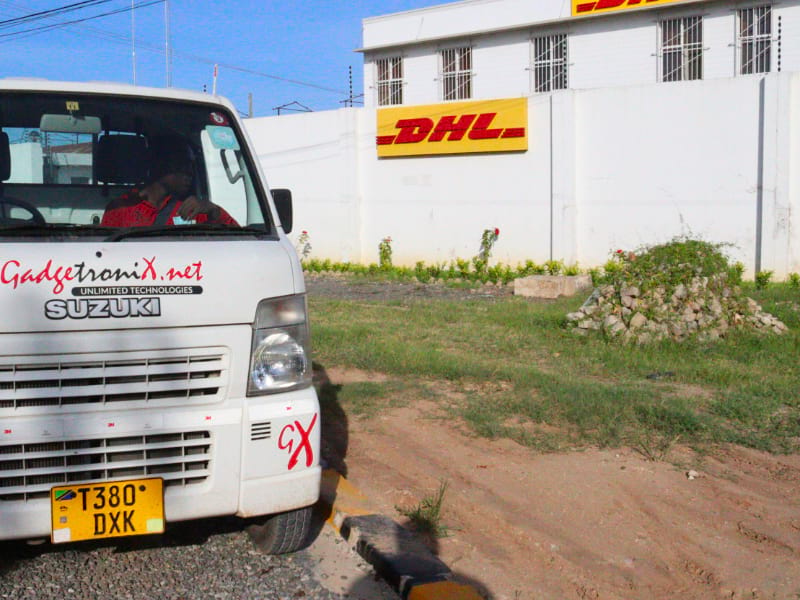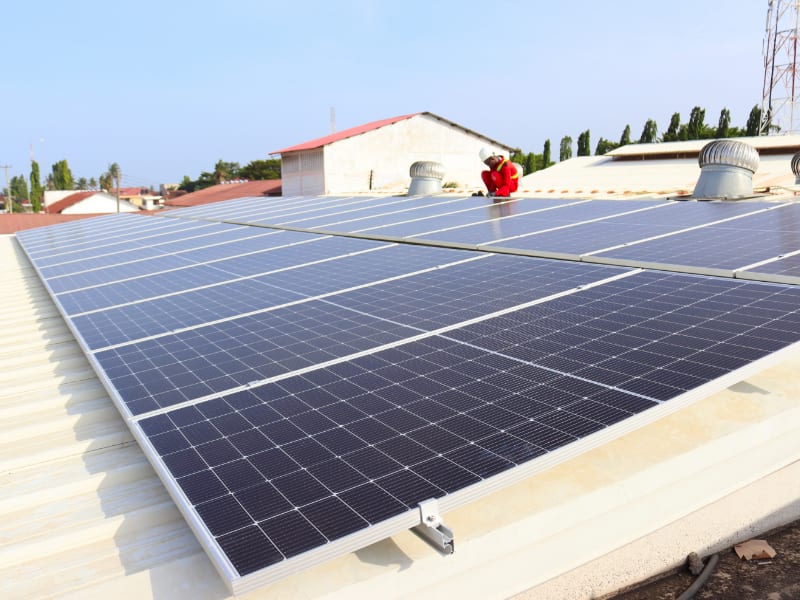
Grid-tied solar power systems are set up to generate electricity from solar panels while remaining connected to the utility grid. This system has grown in popularity among the eco-friendly as it is a good compromise, offering the benefits of solar energy while ensuring a backup power source in case of heavier usage.
Solar Grid-Tied Systems are also among the most affordable forms of individually available renewable energy solutions to date. A perfect solution for those who are not quite ready for a 100% autonomous solar setup, grid-tied systems provide a great alternative with a fast return on investment.
Solar Grid-Tied Structures, often called hybrid solar systems, use photovoltaic panels to generate electricity from sunlight. The direct current produced is then passed through an inverter that converts it into an alternating current, which is usually used to power most house or small office appliances.
During the daytime, most houses need much less energy to run as many people tend to be out during those hours, and systems such as lighting are scarcely needed. In such cases, if the solar power production surpasses the household’s electrical requirements, the excess electricity is fed back into the utility grid. When this happens, the meter can be seen spinning in the opposite direction and earn electric bill credits for the owners of the house. Most governments nowadays have established credit systems that require utility companies to buy this excess energy from individuals through various different renewable energy standards.

However, when the sun falls, and the solar panels produce less power, the missing electricity can be imported from the grid network and fed into the house or business to cater for this shortfall.
Over and above the time of the day, the seasons also impact your energy production and consumption. For a grid-tied solar system, this means that the flow of power sent to and taken from the grid can vary greatly.
Over the summer, when the days are longer and the sun is ever present, your solar panels will produce much more energy. This means that your home will probably get to export much more power than it will take from the grid. Furthermore, your usage may diminish during this period as there is less need for lighting and heating.
On the other hand, during the cold wintery days, your energy requirements will undoubtedly rise to cater to a greater need for heating and fewer hours of sunlight. Less sunshine also implies that your solar panels will produce less electricity and thus import more from the grid.
This type of solar power allows individuals and businesses to run their daily activities at a reduced operating cost. Instead of paying for utility grid power to run their appliances, computers, and machines during the day, solar panels often fully provide the electricity required. In instances where solar power is not enough, electricity is taken from the main power lines. Therefore, on-grid systems can still significantly lower your electricity bill by taking advantage of net metering which allows homeowners to earn credits for every watt of power they export back to the grid.
In addition to lowering your monthly bill, the accumulated credits acquired from the resale of the excess energy can be sold back to utility companies and generate revenues that help you pay back for your installation costs faster.
Much like other solar power systems, grid-tied setups require photovoltaic panels, wiring, racking, and mounting as their primary components for the production of electricity and the ventilation to cool the panels.
However, this specific system also requires a solar grid-tie inverter to transform the DC electricity produced by the panels into AC used in homes and across the grid in general. These inverters are also designed to determine where the power should be distributed in cases of surplus and when to pull in electricity from the grid in case of shortfall. This is done by assessing the energy flow in real-time.

In addition, if not already available in your home, a net meter can be installed once your on-grid solar system is operational. This device allows you to monitor the dual flow of power between the home or office and the utility grid. Net meters provide easily understood readings on the amount of solar power produced and also your daily consumption.
One of the best advantages of staying tied to the utility grid while going solar is that the equipment and installation are much cheaper than other solar systems. Since they can operate with or without a battery, this can greatly influence the equipment cost. Furthermore, labor costs for the setting up of grid-tied solar systems are said to be lower than others as they require the installation of fewer parts and equipment. This reduced initial upfront cost allows you to make greater monthly savings, get a greater return on investment and spend a much shorter period repaying for your purchase.
The ability of on-grid setups to sell back the excess electricity to the grid makes them among the most affordable solar power system kinds, and it also makes it relatively simple to recover your initial investment and benefit from the collected credit points gained

Compared to off-grid systems, this type of solar equipment ensures your house or business can rely on an almost constant power source should you not produce enough to cater to your needs. On less efficient periods such as short winter days, you can benefit from the connection to the utility lines.
In addition, the less equipment required means fewer points of potential failure and damage, and our system runs fewer chances of needing expensive repairs.
The single hiccup of some grid-tie solar systems remains the lack of power during regular power outages. As some systems are not fitted with batteries for energy storage, your home can still be affected by power cuts as they offer no backup. As a safety measure, Solar Grid-Tied Systems are made to switch off when the power on the grid is out to prevent energy from being transferred to the utility lines in case workers are fixing the wires.
However, this issue can easily be fixed by attaching batteries to your system to store some energy to be used during power outages.
As the leading company for shipping services, DHL international set out as pioneers on the journey to greener operations along the freight chain. To date, they have successfully covered over 100 million kilometers of last-mile delivery, meaning the journey from the warehouse to your doorstep. They are also among the first to have established a fleet of around 28,500 bicycles for zero-emission doorstep delivery across Germany.

In order to further expand its sustainability objectives, the company has launched its GoGreen and GoGreen Plus campaigns, allowing its customers to send and receive packages and cargo from emission-friendly transportation solutions. The business has also invested in over 800 million liters of sustainable aviation fuel.
Furthermore, among its many outlets around the world, DHL can be proud to count up to 86% of its energy consumption as coming from renewable green energy. In alignment with this vision, DHL Tanzania has recently invested in the installation of a top-tier grid-tied solar system in its commitment to sustainability.
As a high-impact project for the branch, DHL Tanzania sought the support and expertise of an established renewable energy service provider in the region for the estimation and mounting of the equipment and systems. The GadgetroniX team put to good use its experience after years of working in the field as well as the skill and talent of its highly trained technicians to perform an initial site visit and determine the number of solar panels and other equipment required to power the business.
Once agreed upon, the team actively began the setting up of the photovoltaic panels, inverters, batteries, and other parts. The grid-tie system was installed
in March 2021 and DHL Tanzania has since benefitted from the production of its own renewably sourced electricity. This has allowed the company to fulfill its sustainability promise and significantly reduce the operating power cost required to run its business as the solar system offsets its daytime electricity consumption. Determined on a case-to-case basis, the on-grid system for DHL Tanzania has also been fitted with two Fronius Symo batteries for additional peace of mind.

Join the movement and get the first estimation for your home or business. At GadgetroniX, our team will be glad to walk you through the process and help you determine the best type of solar power system for your needs and vision.
Solar Grid-Tied Systems generate electricity from solar panels while connected to the utility grid. They are affordable, eco-friendly, and offer a compromise between the benefits of solar energy and having a backup power source.
Solar Grid-Tied Systems use photovoltaic panels to convert sunlight into electricity. Any excess electricity produced is fed back into the grid, earning credits. This system unfortunately has not yet been implemented in Tanzania.
The energy production of Solar Grid-Tied Systems varies with seasons. In summer, they produce and export more energy, whereas in winter, they require more energy from the grid.
Solar Grid-Tied Systems reduce operating costs and can significantly lower electricity bills. They allow earning credits for excess power exported to the grid.
Solar Grid-Tied Systems require photovoltaic panels, wiring, racking, and a solar grid-tie inverter, which converts DC electricity to AC and manages power distribution.
Solar Grid-Tied Systems are cost-effective due to lower equipment and installation costs. They also offer a constant power source compared to off-grid systems.
A disadvantage of some Solar Grid-Tied Systems is the lack of power during regular power outages, especially in systems without backup batteries.
